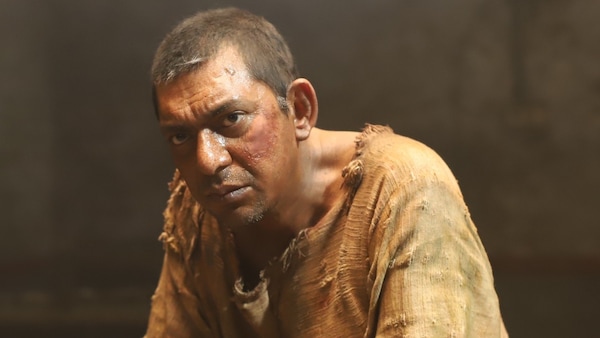Exclusive! Chanchal Chowdhury on Tollywood: I cannot work on a project in a rush. To maintain standard, I will have to spend time in Kolkata
The actor talks about his upcoming Hoichoi web series Karagar, his recent sensational Bangladeshi film Hawa and his plans to work in Kolkata projects.

Last Updated: 07.11 PM, Aug 17, 2022
Bangladeshi actor Chanchal Chowdhury’s recent film Hawa and its song Sada Sada Kala Kala have taken the Bengali audience by storm. While the film is yet to be available for the audience in Kolkata, the song went viral in no time. His web series Karagar will be dropped on Hoichoi on August 19. Before the release, the actor talks about his character in Karagar, his work experience and success story of the Bangladeshi film Hawa and his plans to work in Kolkata projects. Read on…
Tell us about Karagar. In the trailer, we see you as a 250-year-old prisoner. But that’s absurd…
I can only disclose as much as you have watched in the trailer. If I say any further, it will be a spoiler. You will have to watch the series to know what’s going on. I can tell you this, the trailer refers to a prisoner who is behind the bard for 250 years. This has its historical significance. Two hundred and fifty years ago, the subcontinent used to look different. There was no separate Bangladesh and India. As much as we see in the trailer, my character cannot talk. In sign language, he says he has been imprisoned for 250 years. I can confidently claim that in my 25 years of career in TV, film, web series and on stage, I have never worked in a character like this. No one has imagined content like this before. I thank Hoichoi for this web series. Usually, web series follows a certain definition. Karagar is beyond that. It has all the engaging elements of a typical web series. But conceptually, it is much bigger than the usual tropes you see.
You are working on a number of web series on OTT, especially on Hoichoi…
It is a good sign that so much creativity is being deployed in web content. After web series came into the picture, a lot of things are being written and created for the audience beyond TV and films. People pay for your OTT platform and hence, you will have to make something that is value for money. You will have to hold onto your audience.
Taqdeer, your first Hoichoi series, has been well accepted too…
Taqdeer is one of my initial web series. It is a different story made in a very believable, realistic way. It is a thriller. The audience and critics have made it a landmark series. I am thankful for that. The series tells a very realistic story of Bangladesh. It is not a borrowed story of style. It is not an imitation of a foreign story. It has the flavour of our roots and I am thankful to the makers for letting us bring out our flavour and tales.
Meanwhile, your film Hawa has created nothing short of a storm in Bangladesh. In Kolkata, while the film is still unavailable, the song, Sada Sada, Kala Kala, has become a super hit number. What is the reason behind this success you think?
Hawa is a story of fishermen in the sea. The fishermen in our subcontinent take their trawlers and sail in the deep sea. They stay there for 15-20 days, catch fish and keep them in the in-build cold storage in the trawler, and finally, come back to the shore once the storage is full. While many trawlers come back, some don’t. Some of the trawlers face the wrath of sea storms and so on. Hawa is a story of a trawler that encounters some mysterious events. It is also a story of life – a very simple life. In the middle of complex and layered films and web series, the common people in Bangladesh easily relate to the simplicity of Hawa. They trusted the simple lives of the fishermen and loved the innocence of the songs. That is why so much curiosity was generated.
When we were working on Hawa we did not think who would watch it. The production design was such that it took nearly two years to build the script. We rehearsed and attended workshops for six months. We did not go to the water and turned into fishermen overnight. We spent time with fishermen in their village, observed them and learned from them. So, Hawa started many months back. By the time we attended the shooting, we were all prepared.
We heard that you, along with the entire cast and crew of Hawa, spent days in the middle of the sea during the shooting. Will you please elaborate?
Hawa talks about trawlers that voyage into the middle of the sea from where one cannot see the coastline. In reality, we indeed travelled to the middle of the sea. Usually, such shootings take place in a chroma background. But we went to Saint Martin’s Island near Cox Bazar and stayed there for 45 days. Each morning we used to do our makeup and take a small trawler to reach the big trawler. We shot in a real location. I don’t know how we made that happen and how I overcame my fear.
Unlike several heroines from Bangladesh, including Jaya Ahsan and Azmeri Haque Badhon, we don’t see you working with directors from Kolkata in Bengali films. Why is that?
I thank my audience in Kolkata. I worked in Moner Manush in 2010. I wish to work more in Kolkata but there are a few problems. First of all, we are two countries and that involves certain logistics and diplomatic hurdles. Also, I am usually very busy with my work in Bangladesh. Hence, it is easier to work in Bangladesh and I get involved in that. The work pressure is also high.
Next, for me, the standard of work is very important. In Kolkata, I know only a handful of directors and their work. I cannot just get a call, sign a project, take a flight, work and come back. I am not that person. I will have to give it time. I was scheduled to work with Anjan Dutt in a web series and with Srijit Mukherji in Robindronath Ekhane Kawkhono Khete Aashenni. But the pandemic upset that plan. I am sure I will work more in Kolkata. I was in talks with Arindam Sil also.
Do you get to watch Bengali content from Kolkata?
Ever since a young age, I have been watching a lot of Bengali films. Uttam Kumar, Suchitra Sen, Soumitra Chatterjee, Utpal Dutt, Rabi Ghosh, Pahari Sanyal – and I can go on with the list of my favourites. I spent a lot of time watching Bengali films during Covid. I also watch Hoichoi.
In recent times, we can see Bangladesh is going through a transformation in terms of content. Some world-class films and web series are being made and many of those are also getting global recognition. How do you define this?
Every culture has its golden era. We also had. Then that period got over. The standard of arts, culture and literature then started falling. There were several socio-political reasons for that. Then a section of the greedy business community came and started minting money out of these substandard creations. People who valued quality were pushed to the corner. Then they revolted. Artists who went through the crisis of this fall of standard got together and started putting their merit, hard work and diligence together to change the scene. We realised that we will have to create our audience. We will have to produce good content.

 Premium
Premium